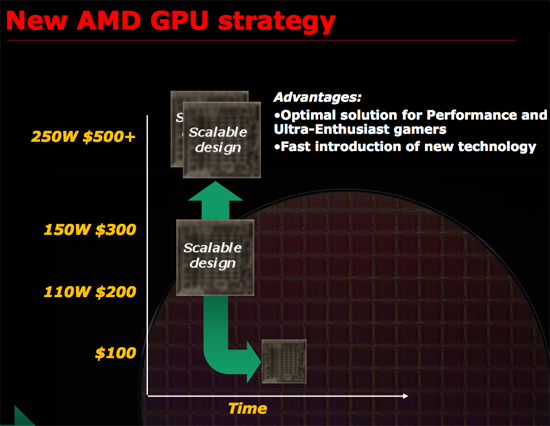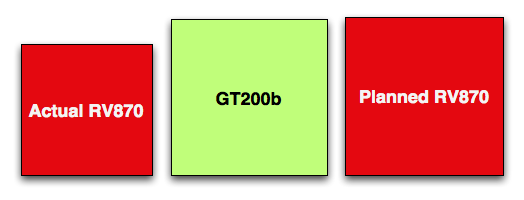The RV870 Story: AMD Showing up to the Fight
by Anand Lal Shimpi on February 14, 2010 12:00 AM EST- Posted in
- GPUs
The Other Train - Building a Huge RV870
While the Radeon HD 5800 series just launched last September, discussions of what the GPUs would be started back in 2006.
Going into the fall of 2007 ATI had a rough outline of what the Evergreen family was going to look like. ATI was pretty well aware of DirectX 11 and Microsoft’s schedule for Windows 7. They didn’t know the exact day it would come out, but ATI knew when to prepare for. This was going to be another one of those market bulges that they had to align themselves with. Evergreen had to be ready by Q3 2009, but what would it look like?
Carrell wanted another RV770. He believed in the design he proposed earlier, he wanted something svelte and affordable. The problem, as I mentioned earlier, was RV770 had no credibility internally. This was 2007, RV770 didn’t hit until a year later and even up to the first day reviews went live there were skeptics within ATI.
Marketing didn’t like the idea of building another RV770. No one in the press liked R600 and ATI was coming under serious fire. It didn’t help that AMD had just acquired ATI and the CPU business was struggling as well. Someone had to start making money. Ultimately, marketing didn’t want to be on the hook two generations in a row for not being at the absolute top.
It’s difficult to put PR spin on why you’re not the fastest, especially in a market that traditionally rewards the kingpin. Marketing didn’t want another RV770, they wanted an NVIDIA killer. At the time, no one knew that the 770 would be an NVIDIA killer. They thought they just needed to build something huge.

AMD's new GPU strategy...but only for the RV770
From August through November 2007, Carrell Killebrew came very close to quitting. The argument to build a huge RV870 because NVIDIA was going to build a huge competitor infuriated him. It was the exact thinking he fought so hard against just a year earlier with the RV770. One sign of a great leader is someone who genuinely believes in himself. Carrell believed his RV770 strategy was right. And everyone else was trying to get him to admit he was wrong, before the RV770 ever saw the light of day.
Even Rick Bergman, a supporter of Carrell’s in the 770 design discussions, agreed that it might make sense to build something a bit more aggressive with 870. It might not be such a bad idea for ATI to pop their heads up every now and then. Surprise NVIDIA with RV670, 770 and then build a huge chip with 870.
While today we know that the smaller die strategy worked, ATI was actually doing the sensible thing by not making another RV770. If you’re already taking a huge risk, is there any sense in taking another one? Or do you hedge your bets? Doing the former is considered juvenile, the latter - levelheaded.
Carrell didn’t buy into it. But his options were limited. He could either quit, or shut up and let the chips fall where they may.

A comparison of die sizes - to scale.
What resulted was sort of a lame compromise. The final PRS was left without a die size spec. Carrell agreed to make the RV870 at least 2x the performance of what they were expecting to get out of the RV770. I call it a lame compromise because engineering took that as a green light to build a big chip. They were ready to build something at least 20mm on a side, probably 22mm after feature creep.










132 Comments
View All Comments
tomoyo - Monday, February 15, 2010 - link
Another awesome article about the real situation behind the hardware from you Anand! I was on the USS Hornet and wish I had talked to you, but it was a great time nonetheless. It's interesting the change in their thought process between the RV770 and RV870, I hope they keep the winning streak up for the next refresh cycle (which hopefully will stay on the market bulges).WT - Monday, February 15, 2010 - link
*sigh* ^^^There's always one in the crowd.
Take care in the fact that you are the only person who hasn't enjoyed this read.
MegaManX4 - Monday, February 15, 2010 - link
Reminds me much of the Anglo-Saxon "documantaries", where it is always of tertiary relevance WHAT is actually discussed, but it is always of utmost interest how the responsible person "feels" about what he is just seeing, other than just stating the facts.There seems to be a huge crowd vowing for that kind of journalism, Whatever pleases the canaille.
"Jedem das Seine" or "to each his own" then
MegaManX4 - Monday, February 15, 2010 - link
This was actually the worst article i have ever read at anandtech. I know that you Americans always strive for emotionally .Driven stories, but this outright borders on silly exaggeration."Heroes of our Industry", what a Schmalz.
Also, if one would take the real informations presented in that article, it wouldn't justify even a 2 Page Article, let alone that 11 Page behemoth.
They are engineers, they do their jobs. Nothing more, nothing less.
Greetings from Germany
blowfish - Monday, February 15, 2010 - link
hmm, with an attitude like that you'll never get past middle management!Like most here, I loved this article. Anand obviously has the friendship and respect of some very senior players, and we were treated to some great insights into how things work at AMD ATI.
As the reader, you can choose to read or not read the article, simple as that. Maybe you should up your medication.
MegaManX4 - Monday, February 15, 2010 - link
unreasonable polemicpmonti80 - Monday, February 15, 2010 - link
You are the one being unreasonable. This may not be a "scientifically written" article, but no one is claiming it to be. And that's the reason this article is so interesting.saiga6360 - Thursday, February 18, 2010 - link
Apparently German engineers are just soulless robots. His confusion is understandable.BelardA - Monday, February 15, 2010 - link
I enjoyed this article even more than the RV770. I do recommend that everyone read that one too.Kind of shocking that Nvidia didn't use that info from the RV770 article to learn to NOT make big GPUs like the GTX 2xx. yeah yeah, it takes 2-4 years to design a chip.
I thank ATI (and AMD) for not playing marketing games like Nvidia does... I think they have a bigger marketing department than engineers nowadays. They started with the GF2-MX 400 & GF4-MX cards (which were re-labeled updated GF2 cards that were not up to GF3 standards)... but the latest cluster-muck of Nvidia products is nothing but a mess. 8800 re-badged as a 9800 re-badged into the gts 250. Code-name of NVxx go to G80 to G92 to G100. The GT-1xx products that are actually low-end 9xxx products, same with most G200 & G300. I'm not going to be surprised when the GTX 285 gets renamed into the GTS450 at $200! I've seen people who bought the GTS250 and post on the internet "why isn't my new gts250 much faster than my old 8800GT"... because you bought a faster version of your card and thought it was something new. Wow, 3 years with 3 names for the same product, that is marketing.
ATI does good with the entire 4000 series being DX 10.1 products and 5000s are DX11. (Does anyone really use HD-5xxx?) It doesn't feel like ATI is pulling our chain with their products.
AMD should be learning from ATI, they are getting better with CPUs - 2 years late, but AMD CPUs are now faster than Core2 and compete well against the lower end intel i-confused model CPUs. There is still room for improvement which was recommend to them some time ago, but AMD is just going to come out with a new design for next year. But had AMD tweaked their CPUs a bit for another 10~20% performance, they'd be up there with i7s.
I hope in the next ATI GPU, some form of Physics engine is added to go up against nvidia's PhsyX. But perhaps that'll be part of DX12... but Microsoft no longer supports Games for Windows.
Actually, with more and more games going ONLY to consoles, I don't think the need for high-end gaming cards will be needed anymore in the next few years. If there are no games, who needs a $300 3D Gaming card?
Zink - Monday, February 15, 2010 - link
Would also like to say great article. I can't wait for new distributed computing cores come out optimized for ATI's architectures.